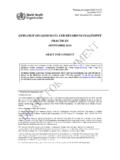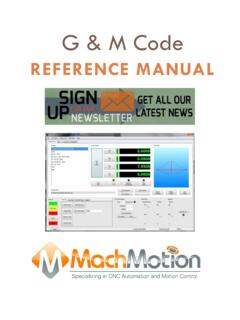Transcription of Chapter 4 Final 0910 - European Commission
1 European Commission HEALTH AND CONSUMERS DIRECTORATE-GENERAL Public Health and Risk Assessment Pharmaceuticals Brussels, SANCO/C8/AM/sl/ares(2010)1064587 EudraLex The Rules Governing Medicinal Products in the European Union Volume 4 good Manufacturing Practice Medicinal Products for Human and Veterinary Use Chapter 4: documentation Legal basis for publishing the detailed guidelines: Article 47 of Directive 2001/83/EC on the Community code relating to medicinal products for human use and Article 51 of Directive 2001/82/EC on the Community code relating to veterinary medicinal products.
2 This document provides guidance for the interpretation of the principles and guidelines of good manufacturing practice (GMP) for medicinal products as laid down in Directive 2003/94/EC for medicinal products for human use and Directive 91/412/EEC for veterinary use. Status of the document: revision 1 Reasons for changes: the sections on "generation and control of documentation " and "retention of documents" have been revised, in the light of the increasing use of electronic documents within the GMP environment. Deadline for coming into operation: 30 June 2011 Commission Europ enne, B-1049 Bruxelles / Europese Commissie, B-1049 Brussel - Belgium Telephone: (32-2) 299 11 11 Table of Contents Principle Required GMP documentation Generation and Control of documentation good documentation Practices Retention of Documents Specifications Manufacturing Formula and Processing Instructions Procedures and records Principle good documentation constitutes an essential part of the quality assurance system and is key to operating in compliance with GMP requirements.
3 The various types of documents and media used should be fully defined in the manufacturer's Quality Management System. documentation may exist in a variety of forms, including paper-based, electronic or photographic media. The main objective of the system of documentation utilized must be to establish, control, monitor and record all activities which directly or indirectly impact on all aspects of the quality of medicinal products. The Quality Management System should include sufficient instructional detail to facilitate a common understanding of the requirements, in addition to providing for sufficient recording of the various processes and evaluation of any observations, so that ongoing application of the requirements may be demonstrated.
4 There are two primary types of documentation used to manage and record GMP compliance: instructions (directions, requirements) and records/reports. Appropriate good documentation practice should be applied with respect to the type of document. Suitable controls should be implemented to ensure the accuracy, integrity, availability and legibility of documents. Instruction documents should be free from errors and available in writing. The term written means recorded, or documented on media from which data may be rendered in a human readable form.
5 Required GMP documentation (by type): Site Master File: A document describing the GMP related activities of the manufacturer. Instructions (directions, or requirements) type: Specifications Describe in detail the requirements with which the products or materials used or obtained during manufacture have to conform. They serve as a basis for quality evaluation. Manufacturing Formulae, Processing, Packaging and Testing Instructions: Provide detail all the starting materials, equipment and computerised systems (if any) to be used and specify all processing, packaging, sampling and testing instructions.
6 In-process controls and process analytical technologies to be employed should be specified where relevant, together with acceptance criteria. Procedures: (Otherwise known as Standard Operating Procedures, or SOPs), give directions for performing certain operations. Protocols: Give instructions for performing and recording certain discreet operations. Technical Agreements: Are agreed between contract givers and acceptors for outsourced activities. Record/Report type: Records: Provide evidence of various actions taken to demonstrate compliance with instructions, activities, events, investigations, and in the case of manufactured batches a history of each batch of product, including its distribution.
7 Records include the raw data which is used to generate other records. For electronic records regulated users should define which data are to be used as raw data. At least, all data on which quality decisions are based should be defined as raw data Certificates of Analysis: Provide a summary of testing results on samples of products or materials1 together with the evaluation for compliance to a stated specification. Reports: Document the conduct of particular exercises, projects or investigations, together with results, conclusions and recommendations. Generation and Control of documentation All types of document should be defined and adhered to.
8 The requirements apply equally to all forms of document media types. Complex systems need to be understood, well documented, validated, and adequate controls should be in place. Many documents (instructions and/or records) may exist in hybrid forms, some elements as electronic and others as paper based. Relationships and control measures for master documents, official copies, data handling and records need to be stated for both hybrid and homogenous systems. Appropriate controls for electronic documents such as templates, forms, and master documents should be implemented.
9 Appropriate controls should be in place to ensure the integrity of the record throughout the retention period. Documents should be designed, prepared, reviewed, and distributed with care. They should comply with the relevant parts of Product Specification Files, Manufacturing and Marketing Authorisation dossiers, as appropriate. The reproduction of working documents from master documents should not allow any error to be introduced through the reproduction process. Documents containing instructions should be approved, signed and dated by appropriate and authorised persons.
10 Documents should have unambiguous contents and be uniquely identifiable. The effective date should be defined. Documents containing instructions should be laid out in an orderly fashion and be easy to check. The style and language of documents should fit with their intended use. Standard Operating Procedures, Work Instructions and Methods should be written in an imperative mandatory style. 1 Alternatively the certification may be based, in-whole or in-part, on the assessment of real time data (summaries and exception reports) from batch related process analytical technology (PAT), parameters or metrics as per the approved marketing authorisation dossier.













